Dealing with a broken key, especially when it snaps off inside a lock, can be a frustrating experience. Keys tend to break due to wearing over time, excessive force, or material fatigue. When faced with a broken key, an immediate priority is to assess the situation and find a quick, temporary fix, particularly if you’re locked out of your home or vehicle.
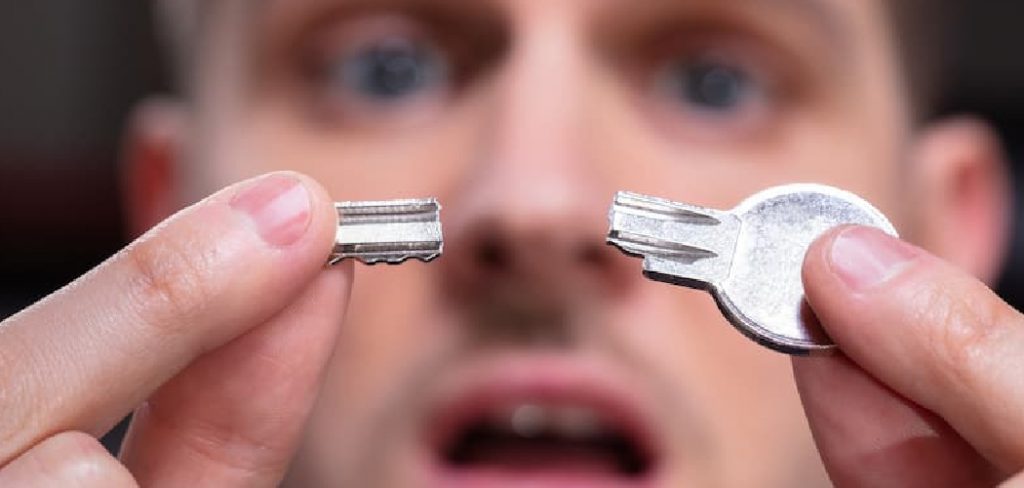
One common method employed is using super glue to reattach the broken pieces of the key. This technique can be particularly useful in scenarios where the key breaks outside of the lock and the fragments are accessible. By applying a small amount of super glue to the broken edges, you can temporarily fix the key to regain access. However, it’s important to note that this is not always the best long-term solution and should be viewed as a temporary measure until a more permanent fix can be arranged. Understanding how to fix a broken key with super glue can save considerable time and hassle in emergencies.
When to Use Super Glue to Fix a Broken Key
Assessing the break is crucial before deciding to use super glue as a solution for a broken key. The key should ideally have a clean, straight break with no bent or missing pieces for super glue to be an effective temporary fix. This is because a neat break allows the two halves to be precisely aligned, offering the best chance for the adhesive to hold the key together securely.
In contrast, if the key has snapped unevenly or any parts are missing, super glue may not be able to provide the stability needed for the key to function properly. Additionally, superglue is generally not recommended if the key has broken inside the lock. Using superglue in such instances can lead to further complications, potentially causing damage to the lock mechanism if not applied correctly.
Suitable situations for using super glue arise when the broken key halves can be aligned neatly, with a straight, unbroken edge making contact. In emergencies, this can offer a temporary solution to reconnect the key and enable you to access your premises. However, it’s important to remember that this is only a stopgap measure. The key should ideally be replaced or rekeyed by a professional locksmith as soon as possible. This minimizes the risk of future breakage, providing long-term peace of mind and security.
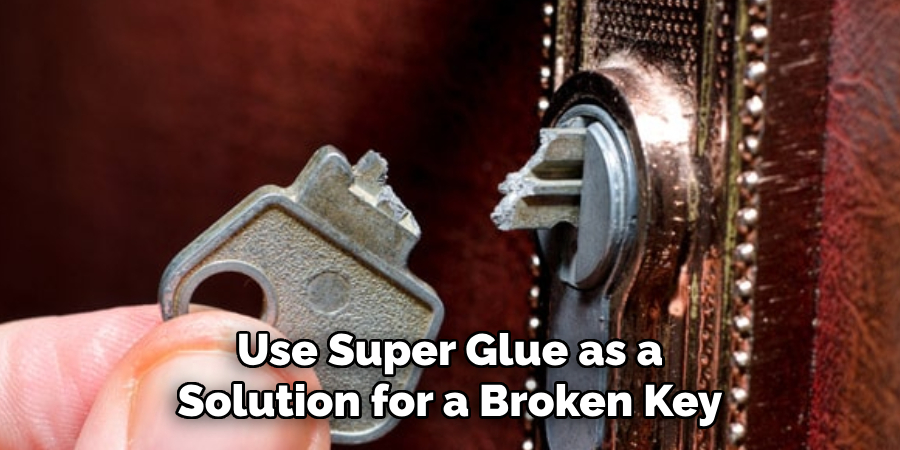
On the other hand, using superglue is not advisable in certain situations. If the broken key is stuck inside the lock, applying super glue can worsen the scenario by causing the key to become permanently lodged or damaging the lock mechanism. This would necessitate more extensive repairs and could lead to additional costs. Similarly, if the key is bent or severely damaged, attempting to fix it with superglue is unlikely to provide a reliable solution and could contribute to further complications. In such cases, seeking professional assistance to address the root of the problem is the best course of action.
Tools and Materials Needed
To fix a broken key with super glue, gather the necessary materials and follow essential safety precautions. Materials required include super glue, preferably a strong, fast-bonding cyanoacrylate adhesive known for its rapid setting time and robust hold.
You’ll also need a paper towel or cloth to clean the key before application, ensuring that any dust or oils don’t interfere with the adhesive bond. Fine-grit sandpaper or a nail file can be useful for smoothing the edges of the break, creating a more aligned and secure fit. Tweezers or needle-nose pliers might be necessary, especially when dealing with small or tight key parts.
Safety is paramount, so consider wearing gloves to avoid gluing your fingers together, and always work in a well-ventilated area to prevent inhaling fumes. To protect your work surface from potential glue spills, lay down a newspaper or a cloth. You can efficiently execute this temporary fix by being prepared with the right tools and observing safety measures.
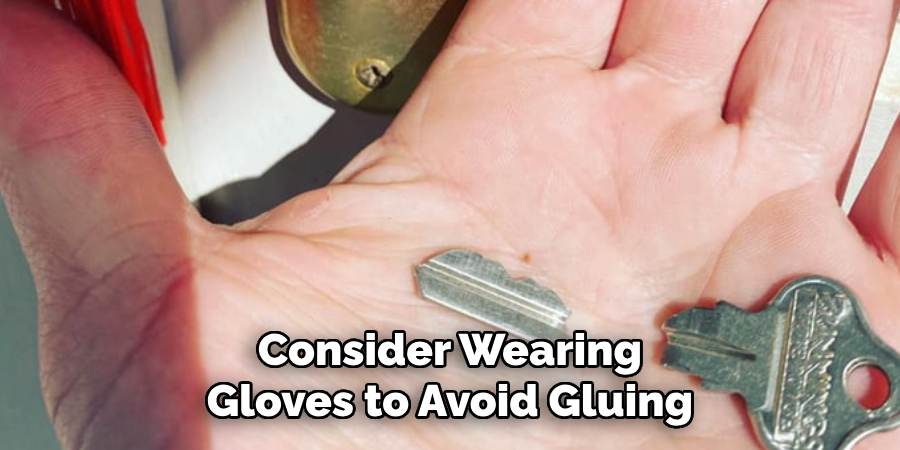
How to Fix a Broken Key with Super Glue: Step-by-Step Guide
This section provides a detailed, step-by-step guide outlining the process of repairing a broken key using super glue. By following these instructions carefully, you can successfully execute this temporary fix, granting you temporary access to your property until a permanent solution is arranged.
Step 1: Clean the Broken Key Pieces
Begin by thoroughly cleaning the broken edges of the key. Use a paper towel or clean cloth to remove any dirt, dust, or oil that might have accumulated on the surfaces. This step is crucial, as superglue forms stronger bonds on clean surfaces. For an even better bond, consider using fine-grit sandpaper or a nail file to gently smooth the broken edges. Take care not to over-sand, as removing too much material might prevent the pieces from fitting together correctly.
Step 2: Align the Key Pieces
Next, hold the two broken key pieces together to assess how neatly they fit. Proper alignment is essential for the key to work correctly in the lock. If needed, use tweezers or needle-nose pliers to carefully handle any small or delicate key fragments, ensuring they align perfectly. Maintaining precise alignment will enhance the durability and function of the repaired key.
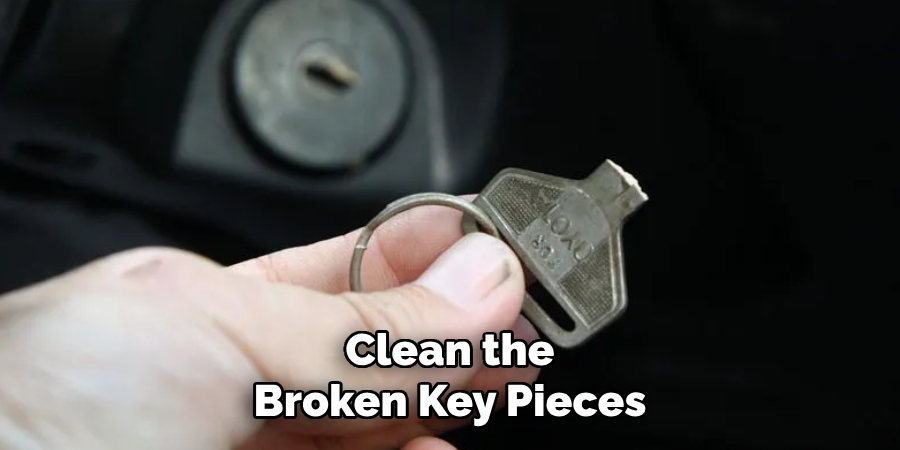
Step 3: Apply Super Glue Sparingly
With the pieces aligned, apply a small amount of super glue to one side of the break. Focus the glue application on the center of the broken area to maximize its bonding effect. Be cautious not to use an excessive amount, as this can lead to glue spillage that may inhibit the key’s functioning within the lock. Additionally, ensure the glue does not spread to any areas that will contact the lock mechanism, as this might cause complications.
Step 4: Press the Pieces Together
Carefully press the broken sections of the key together, maintaining firm pressure for at least 30 seconds. This step is vital to ensure that the glue sets while maintaining the correct alignment. During this time, avoid any movement or shifting of the parts, as it can disrupt the bonding process. In case any glue leaks from the joint, gently wipe it away with a cloth before it hardens.
Step 5: Allow the Glue to Dry Completely
Lastly, let the super glue dry and cure thoroughly, allowing at least 10-15 minutes or the time the manufacturer recommends for a complete cure. Resist the temptation to use the key too soon, as premature usage could compromise the bond and cause the key to break once more. Ensuring the glue fully sets improves the temporary bond’s strength, reducing the risk of a future break until a more permanent repair is performed.
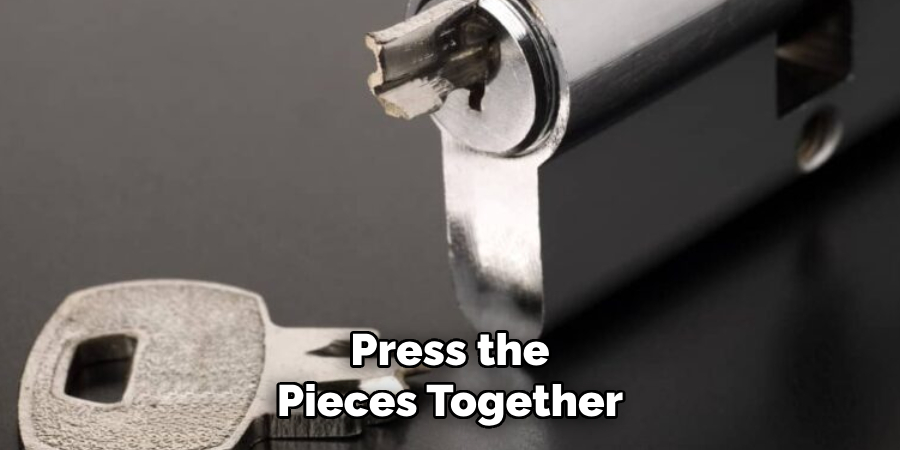
Testing the Repaired Key
Step 1: Inspect the Key
Once the glue has dried completely, carefully inspect the repaired key for any visible cracks or weak spots. Hold the key up to a light source to look for any imperfections affecting its functionality. Test its sturdiness by lightly bending it—ensuring it doesn’t bend easily under slight pressure—while paying attention to any areas that might appear less secure. If the repair appears solid and the key feels sturdy, you can proceed to the next step.
Step 2: Carefully Insert the Key into the Lock
With confidence in the repair, carefully insert the key into the lock. Do this slowly, ensuring that the key slides smoothly without any hesitation or resistance. Be cautious to avoid exerting excessive force, as this may cause stress at the repaired joint. If you feel any resistance or if the key sticks, remove it immediately to prevent further damage. In such cases, reassess the repair; the key may be too weak to withstand operation, and a professional solution may be necessary.
Step 3: Turn the Key Gently
If the key fits smoothly into the lock, attempt to gently turn it. Apply minimal pressure to avoid overstressing the super glue bond, which may still be fragile. Listen for any unusual sounds and stop immediately if the key feels as if it might break again. Remember, this repair is only temporary, meant to provide short-term access to your premises.
It is crucial to seek a permanent solution like key duplication or rekeying as quickly as possible to ensure reliable future access and security. You minimize the risk of future failures and potential lock damage by addressing the root issue with a new key or professional locksmith assistance.
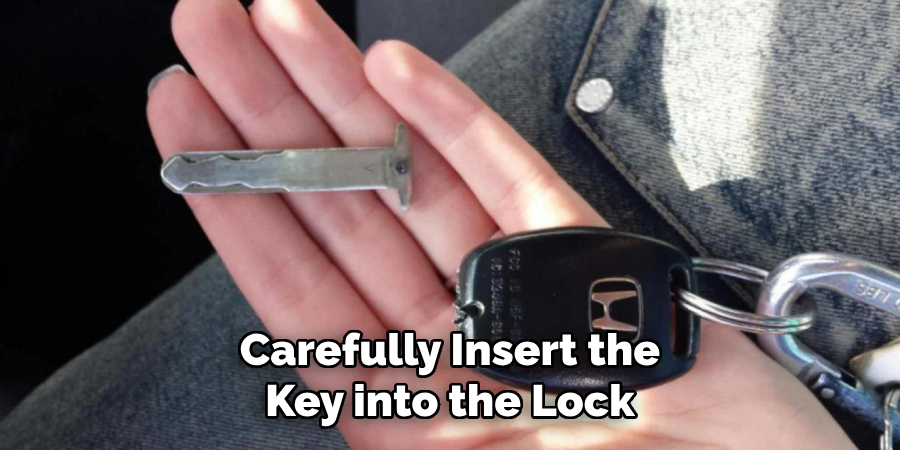
Alternatives and Long-Term Solutions
Duplicate the Repaired Key
Duplication of the repaired key should be your top priority once you’ve confirmed it functions. Despite the temporary fix, the repaired key may suffer from reduced durability and could fail without warning. You ensure continued access even if the original repair gives way by quickly creating a duplicate at a hardware store or locksmith.
Thankfully, most locksmiths have the expertise to duplicate keys accurately, even those that have been previously glued, provided the alignment is still intact. Securing a duplicate can be a cost-effective safeguard that prevents further inconvenience or lockouts from occurring when you least expect it.
Replace the Lock or Rekey It
In cases where the key has suffered irreparable damage or significant wear, replacing the entire lock might be advisable. However, if an outright replacement feels excessive, rekeying serves as a practical middle ground. This process involves altering the lock’s internal pin configuration so it can work with a new key, bringing a renewed sense of security without the expense of a full lock replacement.
Rekeying is particularly useful when all key copies are lost, as it quickly renders old keys useless while providing a fresh start with new ones. Considering these long-term solutions ensures that access to your property remains uninterrupted and secure over time.
Conclusion
In summary, learning how to fix a broken key with super glue involves a series of meticulous steps, beginning with cleaning and aligning the broken pieces, applying the adhesive sparingly, and allowing it to cure completely. This temporary fix is suitable for emergencies, providing short-term functionality and access. However, it’s crucial to understand the limitations of this solution and aim for a more permanent fix.
Duplication of the repaired key offers a quick safeguard against future failures while rekeying the lock ensures enhanced security and reliability. Remember, this method is not a substitute for professional locksmith services when the situation demands it—seeking expert advice can prevent additional damage and keep your mechanisms functioning smoothly. If any doubts arise, consider consulting a locksmith to explore the best long-term solutions.
About
Safety Fic is a distinguished figure in the world of Diy design, with a decade of expertise creating innovative and sustainable Diy solutions. His professional focus lies in merging traditional craftsmanship with modern manufacturing techniques, fostering designs that are both practical and environmentally conscious. As the author of diy, Safety Fic delves into the art and science of Safety Fic-making, inspiring artisans and industry professionals alike.
Education RMIT University
(Melbourne, Australia) Associate Degree in Design (Safety Fic) Focus on sustainable design, industry-driven projects, and practical craftsmanship. Gained hands-on experience with traditional and digital manufacturing tools, such as CAD and CNC software.
Nottingham Trent University
(United Kingdom) Bachelor’s in diyfastly.com and Product Design (Honors) Specialized in product design with a focus on blending creativity with production techniques. Participated in industry projects, working with companies like John Lewis and Vitsoe to gain real-world insights.
Publications and Impact
In diy, Safety Fic his insights on indoor design processes, materials, and strategies for efficient production. His writing bridges the gap between artisan knowledge and modern industry needs, making it a must-read for both budding designers and seasoned professionals.
